Rear Main Seal Leak Symptoms And How to Diagnose
Do you have oil spots in your driveway, or a leaky engine block when you look under your vehicle? Sorry, super bad news: you might have a rear main seal leak.
In fact, few words from the mechanic will stop every driver in their tracks quicker than “You have a rear main seal leak!”
A rear main seal leak is among the worst things that can happen to any vehicle because the rear main seal is very hard to reach and it requires much of your engine to be disassembled. On most modern engines, the seal’s failure is due to a condition inside the engine or a component connected to the back of the engine, and is most common in older cars.
For many drivers, news of such a problem means that it could be time to purchase a new vehicle, because rear main seal repair typically costs more than the value of vehicles old enough to develop such leaks.
Replacing a rear main seal is one of the most dreaded, most labor-intensive and expensive jobs you can do on your car next to replacing the head gaskets or rebuilding your transmission. It can easily cost you from $800 to $1,200 at a mechanic.
In addition, there are no shortcuts or quick fixes if the seal has expired. A replacement isn’t something you’re going to want to take on yourself and even a seasoned mechanic can struggle with it as it’s in a painfully difficult position.
That said, a correct diagnostic will save you a lot of money by having a mechanic check whether your current oil leak situation is indeed a rear main seal leak. In addition, in certain mild cases, you can spend less than $20 to fix the problem.
Read on to learn everything you need to know about rear main seal leak, including how the rear main seal works, rear main seal leak symptoms and causes, how to troubleshoot and what to do.
What does a rear main seal do?
The rear main seal is designed to prevent oil leaks between the block and crankshaft. As it is buried deep in your vehicle’s engine compartment and is hard to reach, manufacturers originally intended rear seals to last the life of a vehicle.
So that no replacement is needed, unlike many other engine components under the hood that require replacement every few years.
The rear main seal is situated just outside of your rear main bearing, which supports the crankshaft for your motor in your engine.
These bearings carry the majority of the load in your engine and play a crucial role in turning the axial motion of your piston into the rotary motion of the crankshaft.
The main bearings do this by absorbing the axial load of the piston being forced down by combustion, all the while still allowing the crankshaft to spin.
To accomplish this task, these bearings have to be incredibly smooth and stay well lubricated by the oil in your engine.
In other words, the correct oil for your engine is extremely important in creating the optimal condition for the main bearings to do their job without excessive wear and tear.
This oil also has to be contained within your engine to continuously keep everything lubricated, and this is exactly where the rear main seal comes in.
The rear main seal allows the crankshaft to exit the engine case so it can bolt to the flywheel or flex plate and transfer its energy into the transmission.
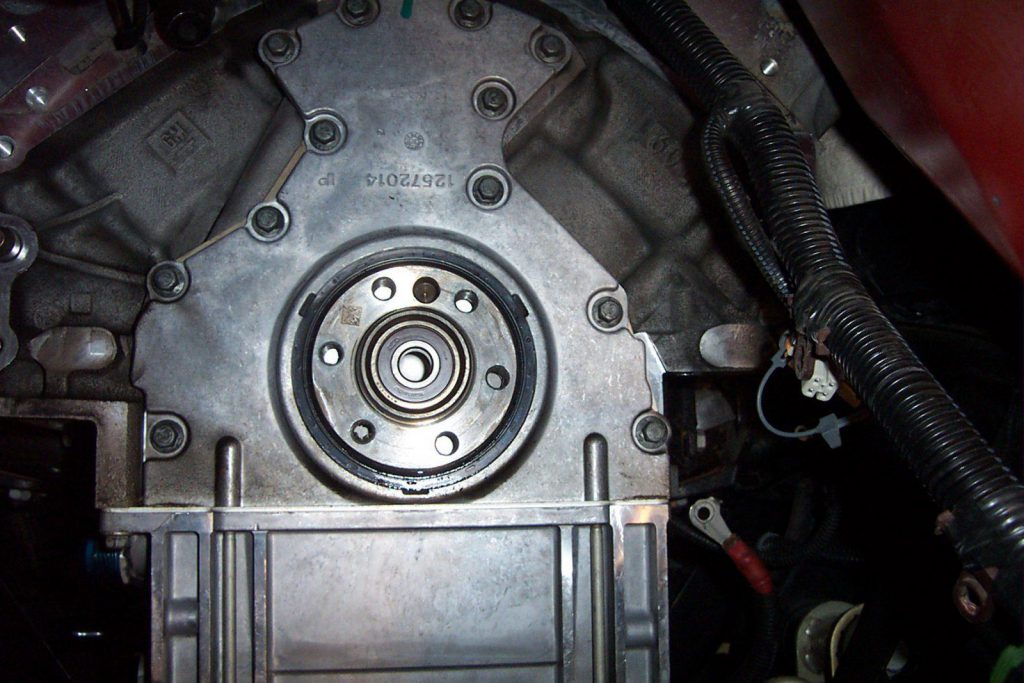
READ MORE:
- Engine Oil Color: Determine If It Needs To Be Changed
- How To Check Engine Oil? The Right Ways To Do It
Rear main seal repair cost
The average cost to repair a leaky rear main seal is anywhere from 800 – 1,200 dollars. In rare cases, some drivers have reported getting quotes of up to 2,500 dollars on certain vehicles.
Is a rear main seal leak serious?
Fast leak and permanent engine damage
Driving with a rear main seal leak is dangerous due to the high possibility of a very fast leak.
A fast leak will lower your engine oil level to dangerous levels very quickly, which can lead to permanent engine damage.
The possibility of a fast leak is very likely, as the rear main seal is in a place that gets a lot of oil thrown at it and has the added wear of the crankshaft spinning inside.
If the seal tears or cracks even only slightly, the crankshaft rotation can cause the seal to get torn up very quickly causing a fast leak.
A quick side note is that when a vehicle is parked at an angle, an oil leak is bound to escalate much faster.
Therefore, if your driveway is built on an incline, park your car on the level street in front of your house until the problem is fixed.
On vehicles with manual transmission, the clutch disc can become soaked with oil if you let a leak persist for too long.
High risk of leak
Some seals and gaskets in your engine never cause severe leaks because of the design or because they are not subjected to high oil pressure in the engine. In contrast, the rear main seal is an engine component that is highly likely to develop a leak.
No matter how often you change your oil, eventually the spinning metal crankshaft will wear down the seal enough to cause a leak.
Expensive repair and replacement
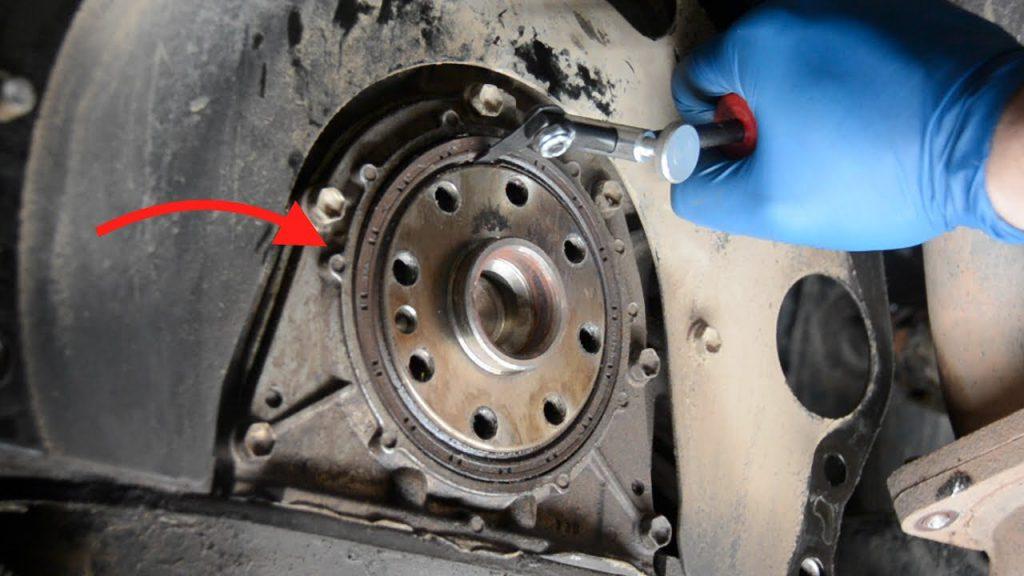
As mentioned before, rear main seal inspection and replacement require much of your engine to be disassembled. Therefore, labor costs would be very expensive and of course, if you are not a professional handyman, this would be a very complicated project.
The problem is the location of the rear main seal. It is at the back of the engine and seals the crankshaft as it exits the engine.
Your vehicle’s flywheel or flexplate is then bolted onto the crankshaft flange sandwiching your rear main seal between your engine and transmission.
To replace the seal, either the engine or transmission will have to be removed. Once one of those is removed, the oil pan also has to come out too, so this maintenance job is extremely labor intensive.
Types of rear main seal
The majority of older vehicle models use the rope or wick seal, with a small number using the split seals. Meanwhile, newer models use the one-piece seal for improved performance.
Rope seals and split seals are much more universal and can work on almost any engine, while one-piece seals are less prone to leaks.
Rope or Wick Seal
Named because of its resemblance to rope and lamp wicks, this seal is designed to handle the impacts of intense crankshaft rotations and the friction caused by fluctuations in temperature.
Consequently, a rope/wick seal can fail in two ways: shrinking in cold weather or expanding in hot weather.
The seal is lubricated to avoid drying out with a small amount of oil, which also keeps it fitted in its place next to the crankshaft.
In modern cars, the new design of rope seals lack the strength of the older version when it comes to preventing stray oil.
According to many professionals and specialists, such a change in design is due to stricter environmental regulations, which have restricted the use of materials like asbestos.
Such regulations forced manufacturers to cut corners to lower the cost of producing the rear main seal.
As a result, most modern day rope/wick seals are vulnerable to crankshaft contact and engine speed, and therefore need to match the RPM requirements of your engine.
To avoid bad replacement rope/wick seals, only buy from reputable parts suppliers and best to check reviews on Amazon before making a purchase.
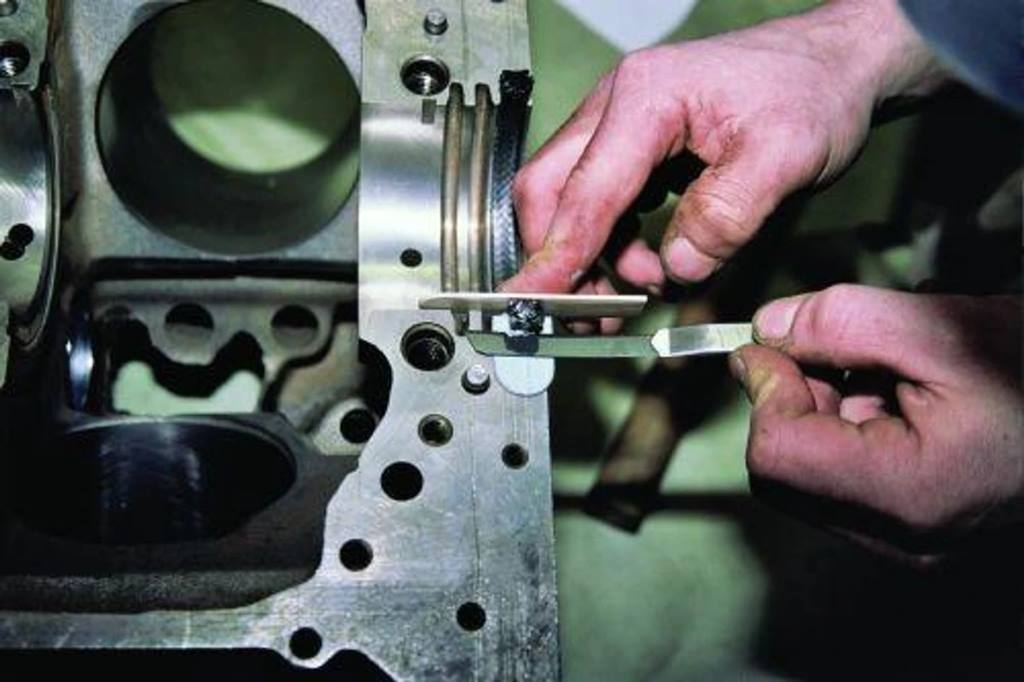
Neoprene or Split Seal
Made of rubbery material, the split seal has a lip shape and is fitted in one direction to prevent the passage of oil. Though effective for this purpose, neoprene seals are equally vulnerable to leaks as rope/wick seals.
One-Piece Seal
One-piece seals are the hardest seals to service and lack the universality of rope and split seals.
With its unique round design, the one–piece seal only works on specially-made crankshafts. Therefore, you cannot install one–piece seals in older engines without a crankshaft replacement.
Rear main seal leak symptoms
The issue can be hard to identify because the parts in question are relatively unknown to most car owners.
The hard-to-reach location of the rear main seal goes to show how this part of the vehicle was never really intended to be replaced during the span of the car’s ownership.
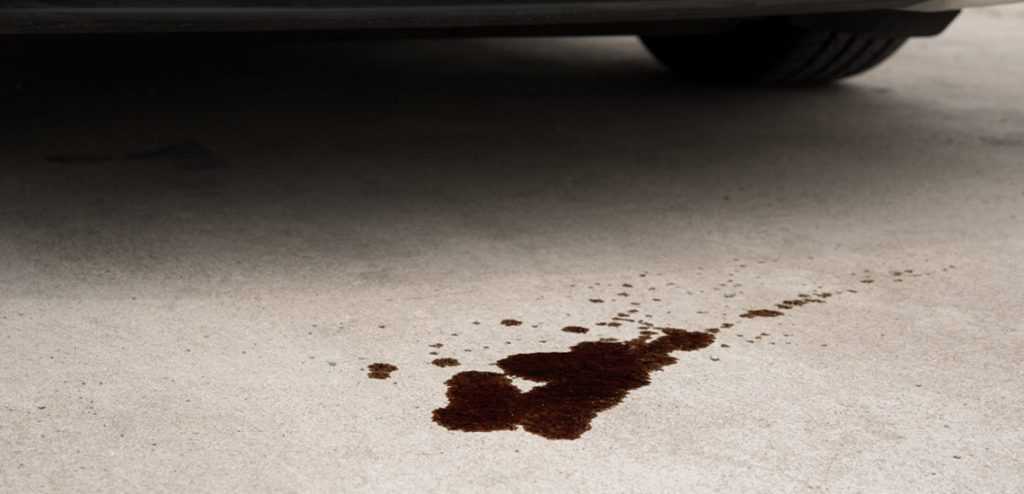
How to tell if rear main seal is leaking? The main symptom of a rear main seal leak is when your car starts leaving black stains on your driveway or parking lot.
Another sign is aggressive oil loss: you find yourself needing to top off your oil more frequently, despite the same routes and driving conditions.
At the early stage of a leak, oil loss might not be rapid enough that you would find black stains where the vehicle has parked.
While you might see an oil stain in your driveway overnight, the leak might not be fast enough to leave its mark in the supermarket parking lot on your grocery trip. Therefore, you might need to run tests to determine whether you’re losing oil or not.
>> READ MORE: How To Replace A Rear Main Seal Without Removing The Transmission
Rear main seal leak causes
There are many rear main seal leak causes. Any of the following conditions can cause your rear main seal to leak because they can deform or deteriorate the seal.
Worn main bearings
If your vehicle has worn main bearings, the crankshaft will move excessively inside the bearings which will stretch and move the rear main seal while the engine is running. This will allow oil to leak past the seal.
It is difficult to tell if your engine has worn main bearings without removing a lot of components.
If this is the cause, you’re most likely in for a full engine rebuild which would include removing the motor and replacing many other components in addition to the rear main seal itself.
Clogged or blocked PCV system
Most rear main seals have a lip that rides on the shaft. The pressure inside the crankcase will push the lip onto the shaft. Too much pressure will eventually cause the lip to balloon and allow oil to pass.
Then when will there be too much pressure? If the Positive Crankcase Ventilation (PCV) system is blocked, it will increase the pressures inside the crankshaft and push out the seal.
Otherwise, if the engine is supercharged or turbocharged, excessive blowby due to worn or damaged piston rings can cause increased crankcase pressure that can also damage the rear main seal, causing a leak.
Engine oil condition
Another common cause could be due to a low oil level or using the wrong type of oil. Most oils have chemicals in their additive packages that will condition the seals in the engine. If the oil is not changed regularly, it will cause the seal to deteriorate.
The seal conditions are depleted over time along with buffers in the oil. The lip that rides on the crankshaft will become stiff and will not be able to seal itself against the crankshaft.
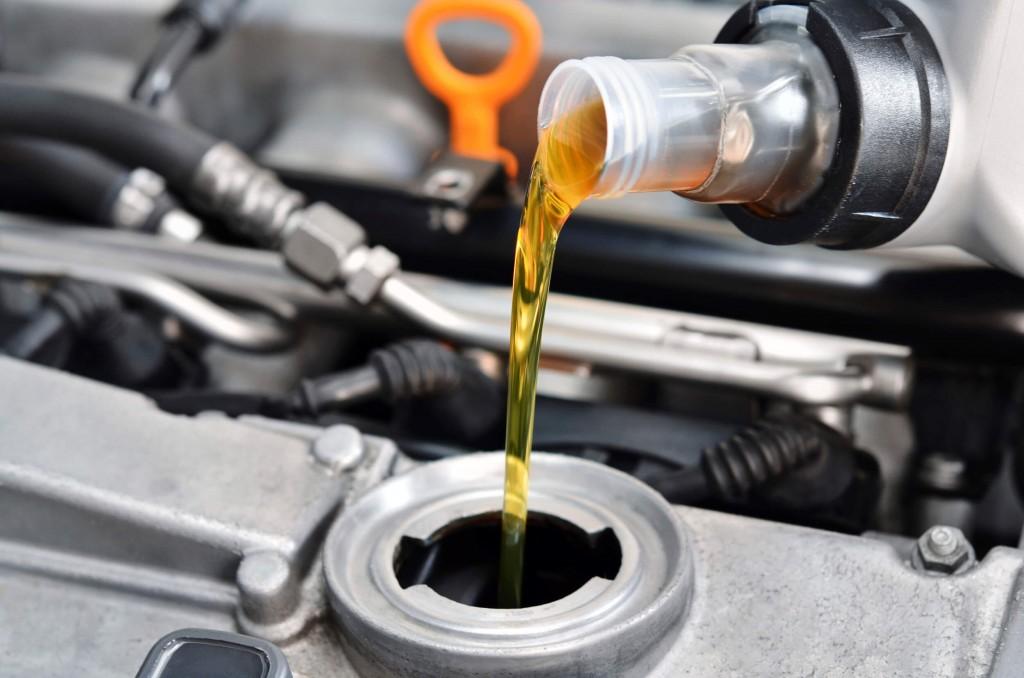
Crankshaft condition
The rear main seals have a lip that directly rides on the crankshaft. Therefore, the condition of the surfaces that the rear main seal rides on is critical.
Any imperfections or wear on the crankshaft can cause a leak. There are sleeve kits that can be installed on the crankshaft to restore the surface.
Misalignment issues
If there are any alignment problems with the bell housing or input shaft of the transmission, they can cause stress on the rear main seal.
Make sure you check the input shaft on a manual transmission. On vehicles with automatic transmissions, check the flex plate for lateral runout or damage.
Seal coating
In rarer cases, some rear main seals need to be installed dry. These seals have a polytetrafluoroethylene (PTFE) coating on the lip seal that needs to be dry and seat to a dry surface on the crankshaft.
The seal will transfer a layer of PTFE to the crankshaft surfaces that the lip will ride on.
The transfer layer prevents wear while sealing better than a silicone or Viton material. If the seal is installed with a coating of oil, it will start to leak in a few miles.
Rear main seal leak: Troubleshooting
Since the rear main seal is in a position that you won’t be able to slide under your car and inspect directly, your best course of action upon finding stains in your garage is to go through a process of elimination.
If you seem to be losing oil but you don’t have a noticeable drip when the car is parked you may be in the early stages of a leak.
Idle the engine
The first step and a simple way to test if your car is leaking oil is to idle the engine for 15 minutes to see whether any oil appears on the surface underneath.
Since the car’s movement and other car parts can tend to hide oil leak symptoms, most evidence of leaks is overlooked.
For example, oil could be getting splashed along chassis components as you drive at highway speeds.
By running the car at a standstill, you get a better indicator of how oil is consumed during commutes along roads and highways.
Using dye
In the case that you’re finding oil stains or experiencing excessive oil loss, it is not necessarily your rear main seal that is leaking.
On most engines, oil leaks can occur above and below the rear main seal. It could be a leaking oil pressure sensor, oil pan gasket or galley plug near the seal that causes oil to come from the bell housing. Adding dye to the oil can help reveal where the oil is coming from.
Check the transmission and oil pan
If you have determined that your car is leaking oil, check the transmission and oil pan. If oil appears on the front of the transmission and at the back of the oil pan, it could be due to a rear main seal leak, but there are still other possibilities.
Therefore, it’s important to check further up in the engine compartment for drips. After all, you might discover a critical yet different problem with your vehicle that would ultimately be easier and cheaper to fix.
Check valve cover gasket and valley pan
Other places to inspect for leaks are the valve cover gasket and valley pan. The cover gasket and valley pan are easier and less expensive to replace than the rear main seal.
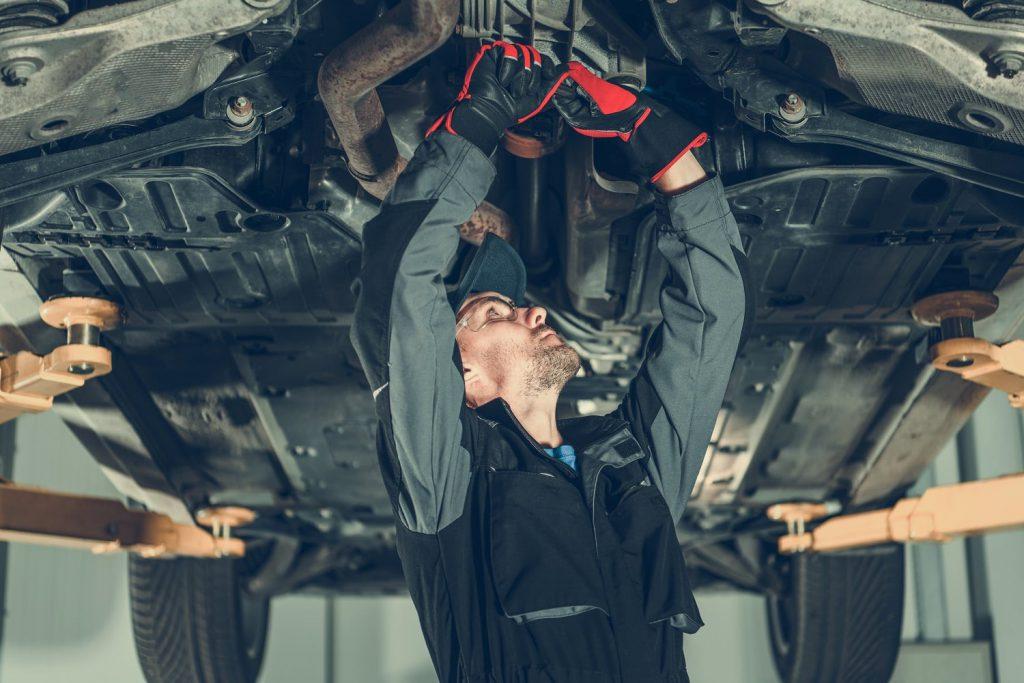
You’ll need to get under the vehicle with a flashlight to check these parts. For added protection, you’ll probably want to put on grubbies, goggles and protective gear around your head.
Rear main seal leak fix for non-serious situations
Oil Stop Leak
You are extremely lucky if your seals have simply shrunk or are slightly deformed due to a lack of frequent oil changes and thus only need to be reconditioned without having to be replaced.
Very often, engine seals become dry and crack, due to heat, oil acidity, and a host of other maintenance-related results, usually from a lack of maintenance.
In this case, very often simply reconditioning them can bring them back to life for a short period, and they will perform just fine for tens of thousands more miles.
However, of course, you cannot expect to drive a car 500,000 miles and expect the rear main seal to never fail again.
To recondition your rear main seal, look for an oil-stop leak product. These oil stop leak products can recondition the seals.
Or at least in some cases prolong the leakage and slow it down long enough for you to either keep driving it the way it is for a while or buy you some time until you can save up enough money to get it fixed by a local mechanic.
Do note that these will not work if your rear main seal has a hole, tear, or a chunk missing out of the gasket seal itself. No product will be able to replace the giant hole in the rubber seal material itself without taking the car apart.
There are a few specific ones from three reputable companies, including BlueDevil Rear Main Sealer ($15/8oz), AT-205 Seal Leak Stopper ($10/8oz), and Bar’s Leaks 1040 Grey Concentrated Rear Main Seal Repair ($5/17oz).
Check out this video from Wrenching With Kenny to learn more about some helpful tips to avoid rear main seal leak issue!
Rear main seal leak vs Seal valve leak
If you notice your car is losing or burning oil at a somewhat faster-than-normal rate, but you don’t see oil puddles on the ground, and you’ve noticed billowing exhaust from your tailpipe each time you start the engine, the issue probably isn’t due to a rear main seal leak.
Instead this can be caused by a valve seal leak, a pretty common problem.
Common causes of seal valve leaks include vehicle age and mileage. However, the most likely reason for a seal leak is the prolonged storage of a vehicle.
When you store a vehicle in a garage for weeks or months on end, the seal can dry and harden, which can ultimately lead to cracks and leaks.














